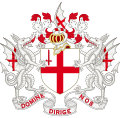History and functions
The Salters' Company was first granted a Royal Charter of Incorporation in 1394, with further charters authorising the Company to set standards regulating salt industry products from the City of London. The formal name under which it is incorporated is The Master, Wardens and Commonality of the Art or Mystery of the Salters of London. [2]
The Company was originally responsible for the regulation of salt merchants, but began losing control over the trade as the population of London increased and spread outwards from the City after the Industrial Revolution. Until the 19th century, the main use for salt was to preserve food for the winter months. Salt was probably the first traded commodity which if not available locally was imported. [3]
Through careful stewardship of financial bequests and funds, the Company now serves as a significant educational and charitable institution whilst maintaining links with its heritage by supporting education in chemistry, for example by awarding scholarships to chemistry and science students, among whom is Sam Carling MP . [4]
Since Sir Robert Bassett (for 1475/76), eighteen Salters have served as Lord Mayor of London, the most recent being Sir Richard Nichols (for 1997/98). [5]
The Master Salter for 2025/26 is Andrew McMurtrie JP , [6] supported by the Company Wardens Anthony Cecil, 4th Baron Rockley, [7] John Stebbing FRCS [8] and Matthew Previte. [9]
Since 2019, the Clerk to the Salters' Company is Lt-Col. Tim Smith. [10]
This page is based on this
Wikipedia article Text is available under the
CC BY-SA 4.0 license; additional terms may apply.
Images, videos and audio are available under their respective licenses.


